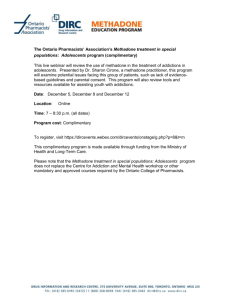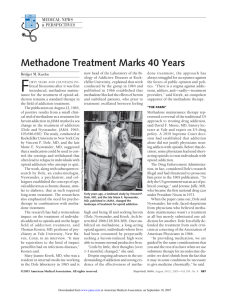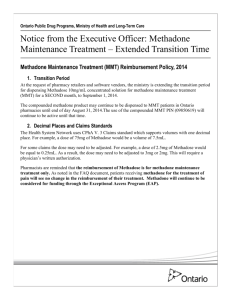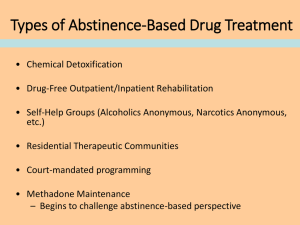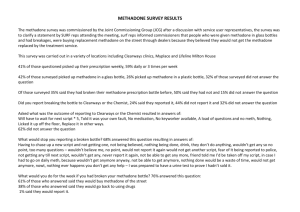Slides - International Conference on Opioids
advertisement
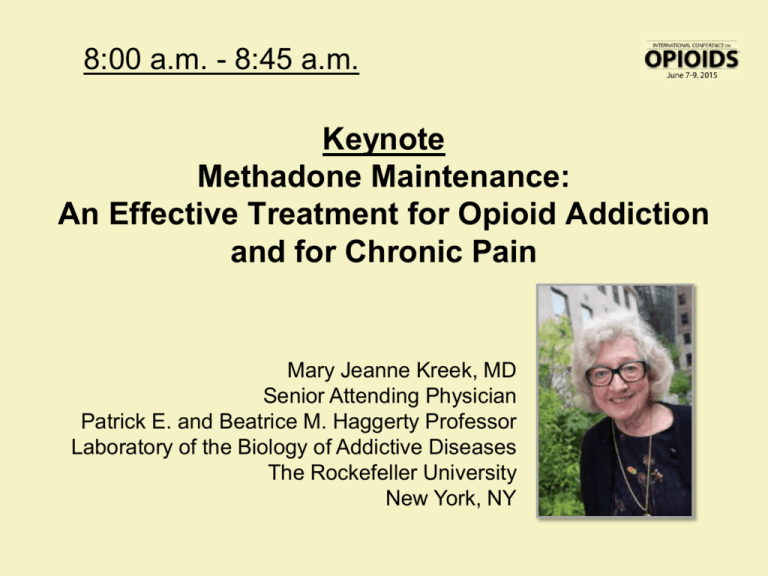
8:00 a.m. - 8:45 a.m. Keynote Methadone Maintenance: An Effective Treatment for Opioid Addiction and for Chronic Pain Mary Jeanne Kreek, MD Senior Attending Physician Patrick E. and Beatrice M. Haggerty Professor Laboratory of the Biology of Addictive Diseases The Rockefeller University New York, NY Methadone Maintenance: An Effective Treatment for Opiate Addiction and Chronic Pain Mary Jeanne Kreek, M.D. Patrick E. and Beatrice M. Haggerty Professor Head of Laboratory The Laboratory of the Biology of Addictive Diseases The Rockefeller University Senior Physician The Rockefeller University Hospital June 8, 2015 International Conference on Opioids Boston, MA funded primarily by NIH-NIDA, NIH-NCRR and the Adelson Medical Research Foundation Prevalence of Specific Drug Abuse and Vulnerability to Develop Addictions 2015 National Household Survey and Related Surveys – 2007 – 2014 Alcohol Use – ever ~ 260 million Alcoholism ~ 16.5 million Marijuana Use – ever Marijuana Daily Use ~ 104 million ~ 5.7 million Cocaine Use – ever Cocaine Addiction ~ 45.6 million ~ 2 to 3 million Heroin Use – ever Heroin Addiction ~ 5.7 million ~ 1 million Illicit Use of Opiate Medication – ever ~ 37.1 million (i.e., 14.2% of the population 12 and over)* Dependence on Such Medication Use ~ 2 million * 2007 National Survey on Drug Use and Health SAMHSA National Survey on Drug Use and Health, 2014; NIDA Monitoring the Future 2014; Others, 2007-2015 Development of Addiction After Self-Exposure to Specific Drugs Alcoholism ~ 1 in 8 to 1 in 15 (12.5% to 6.5%) Marijuana ~ 1 in 8 to 1 in 15 (12.5% to 5.5%) (estimate) Cocaine Addiction ~ 1 in 8 to 1 in 15 (12.5% to 6.5%) Heroin Addiction ~ 1 in 3 to 1 in 5 (33.3% to 17.5%) SAMHSA National Survey on Drug Use and Health, 2012; NIDA Monitoring the Future 2014; Others, 2007-2015 1 Number of Unintentional Drug Overdose Deaths Involving Prescription Opiates, Heroin, and Cocaine (United States, 1999-2007) and Rate of Overdose (1970-2007) Number of Unintentional Overdose Deaths Rate of Overdose 10 12,000 Opioid Analgesic 10,000 Cocaine 8 Heroin 8,000 Rate* Deaths 14,000 6,000 4,000 6 4 2,000 0 1999 2000 2001 2002 2003 2004 2005 2006 2007 2 23.5 million persons aged 12 and older needed treatment for an illicit drug or alcohol abuse problem. Only 2.6 million received treatment at a specialized facility. (SAMHSA 2009) 0 1.9 people die every day from heroin overdoses in New York City. (NYC Dept of Health – 2013) 1970 1975 1980 1985 1990 1995 2000 2005 * Per 100,000 population More than 1 person dies every hour in the United States from prescription opiate overdose. (T Frieden, CDC – July 2014) National Vital Statistics System; MMWR 61:1, 2012 Natural History of Drug and Alcohol Abuse and Addictions Primary Prevention Possible Utility of Vaccines and Selected Medications Initial Use of Drug of Abuse Sporadic Intermittent Use Medications Useful and Needed Regular Use Addiction 70%-90% without pharmacotherapy relapse to addiction Early Protracted Withdrawal Abstinence (abstinence) Progression ADDICTION: Compulsive drug seeking behavior and drug self-administration, without regard to negative consequences to self or others (adapted from WHO). 10-30% sustain abstinence with no specific medications Adapted from Kreek et al., Nature Reviews Drug Discovery, 1:710, 2002; 2013 The Beginning: 1963-1964 Treatment of Heroin Addiction: Identification of Need, Formulation of Hypothesis, Basic Clinical and Related Laboratory Research, Translational Research, and Evaluations Autumn 1963 Vincent P. Dole, Jr., MD recruitment of two new staff members to his Laboratory of Physiology and Metabolism at The Rockefeller Institute for Medical Research: 1) Marie Nyswander, MD – psychiatrist, years of work with heroin addicts in New York City and Lexington, KY. Author of book The Addict as a Patient. 2) Mary Jeanne Kreek, MD – second year Resident in (Internal) Medicine (“PGY-2”) at Cornell-New York Hospital with experience in clinical and laboratory based research at NIH and Columbia P&S. January – July 1964 New team formed and first patients admitted to the Rockefeller Hospital; initial research accomplished by July. AATOD 2013; EUROPAD 2014 2 50th Anniversary of Development of Methadone Maintenance Treatment Vincent P. Dole, Jr., MD; Marie Nyswander, MD; and Mary Jeanne Kreek, MD 1964: Initial clinical research at The Rockefeller Hospital on development of treatment using methadone maintenance pharmacotherapy and on elucidating mechanisms of efficacy. Dole, V.P., Nyswander, M.E. and Kreek, M.J.: Narcotic blockade. Arch. Intern. Med., 1966. What is Addiction? Compulsive drug seeking behavior and drug self-administration, without regard to negative consequences to self or others. (adapted from WHO) “drug” = nicotine, alcohol – legal drugs prescription opiates, marijuana (cannabis) – medicines (?) heroin, cocaine – illegal drugs 2015 50th Anniversary of Development of Hypothesis on Addictive Diseases 1964 HYPOTHESIS – NOW EVIDENCE-BASED FACT: Heroin (opiate) addiction is a disease – a “metabolic disease” – of the brain with resultant behaviors of “drug hunger” and drug self-administration, despite negative consequences to self and others. Heroin addiction is not simply a criminal behavior or due alone to antisocial personality or some other personality disorder. Dole, V.P., Nyswander, M.E. and Kreek, M.J.: Narcotic blockade. Arch. Intern. Med., 1966. 3 Development of Methadone Maintenance Treatment – 1964 Onward Initial clinical research on mechanisms and treatment using methadone maintenance pharmacotherapy at The Rockefeller Hospital of The Rockefeller Institute for Medical Research (by the mid-1960s, The Rockefeller University) performed by the team of: Vincent P. Dole, Jr., M.D. Professor & Head of the Laboratory of Physiology and Metabolism (deceased 2006) Marie Nyswander, M.D. Guest Investigator – Joined Dole Lab in Winter 1964 (deceased 1986) Mary Jeanne Kreek, M.D. Guest Investigator – Joined Dole Lab in Winter 1964 (now Professor & Head of Laboratory) First publications describing methadone maintenance treatment research 1) 1964: Initial clinical research on development of treatment using methadone maintenance pharmacotherapy and on elucidating mechanisms of efficacy performed at The Rockefeller Hospital of The Rockefeller Institute for Medical Research: Dole, V.P., Nyswander, M.E. and Kreek, M.J.: Narcotic blockade. Arch. Intern. Med., 118:304-309, 1966. (also recorded in the Association of American Physicians meeting transcription of discussion) 2) 1965: Translational applied clinical research performed at Manhattan General Hospital: Dole, V.P. and Nyswander, M.E.: A medical treatment for diacetylmorphine (heroin) addiction. JAMA, 193:646-650, 1965. AATOD 2013; EUROPAD 2014; MACAU 2015 Original basic clinical research at the Rockefeller Hospital – January – July 1964 Dole, Nyswander, and Kreek, Arch. Intern. Med., 118:304,1966 Presented by VP Dole at the “Old Turks” Meeting (Association of American Physicians), May 1966 … … Dole, Nyswander, and Kreek: Narcotic Blockade: a medical technique for stopping heroin use by addicts. Trans. Assoc. Am. Phys., 79:122-136,1966 4 1964-1966: Early Expansion of Methadone Maintenance Treatment 1964-1967 – Initially all patients admitted as active or recently abstinent heroin addicts to the Rockefeller Hospital, unlocked research ward for inpatient induction into methadone maintenance treatment (minimum 6-8 weeks). Follow-up in Rockefeller Hospital Outpatient Department. 1965-1966 – Replication of methadone maintenance treatment research model in an inpatient unit of the Manhattan General Hospital, a fee-for-service proprietary hospital, which had been engaged in 10-14 day detoxification “treatment” for opiates (revolving door). Kreek, AATOD 2013; EUROPAD 2014 1967-1972: Continued Early Expansion of Methadone Maintenance Treatment 1967-1968 – Introduction of outpatient induction into methadone maintenance treatment (at the Rockefeller Hospital clinic, Dr. MJ Kreek). 1967-1972 – Development of multiple satellite outpatient methadone maintenance treatment programs at Harlem, Beth Israel, St. Luke’s, and Roosevelt Hospitals in New York City. 1967-1972 – First replication of methadone maintenance program outside of New York City – Department of Psychiatry, University of Uppsala, Uppsala, Sweden (Dr. Lars Gunne and later Drs. Leif Grönbladh and Olof Blix). 1971 – Development of “Adolescent Development Program” in the Department of Public Health of Cornell Medical College – New York Hospital (Drs. Elizabeth Khuri and R. Millman). 1972 – Development of “Adult Clinic” in the Department of Medicine of Cornell Medical College – New York Hospital (Dr. Aaron Wells). Kreek, AATOD 2013 ; EUROPAD 2014 Prospective studies of first 214 patients admitted to methadone maintenance research and treatment (January 1964 – July 1966, and followed-up for three years or more) along with retrospective study of 1435 methadone maintenance patients and special studies in a smaller group. 1973 5 1973 Functional State (Heroin) Impact of Short-Acting Heroin versus Long-Acting Methadone Administered on a Chronic Basis in Humans 1964 Study and Opioid Agonist Pharmacokinetics: Heroin Versus Methadone (1973-mid-1980s) "High" "Straight" Drug or Medication Apparent Plasma Terminal Half-life and Duration of Desired Effects HEROIN 3 min for prodrug 30 min for active compound (fast on-set and off-set "Sick" AM PM AM PM AM Functional State (Methadone) Days 6 hours for active metabolites "High" METHADONE "Straight" "Sick" 24h for medication (slow on-set and off-set) 48h for active half of medication AM PM AM Days H PM AM Dole, Nyswander and Kreek, 1966; Kreek et al., 1973; 1976; 1977; 1979; 1982; Inturrisi et al, 1973; 1984; 2015 “On-Off” versus “Steady-State”: Relationship Between Blood (and Brain) Levels of Drugs of Abuse and Their Effects Disruption versus Normalization • levels of gene expression • receptor mediated events • physiology • behaviors Rates of rise of blood (and presumable brain) levels of drugs of abuse are related positively to their reinforcing effects Rates of fall of blood (and presumably brain) levels of drugs of abuse are related positively to the onset of withdrawal symptoms and/or acute “craving” Kreek, 1978;1987;1991;1992; 2001 6 Goals and Rationale for Specific Pharmacotherapy for an Addiction 1. Prevent withdrawal symptoms 2. Reduce drug craving 3. Normalize any physiological functions disrupted by drug use, including especially brain function 4. Target treatment agent to specific site of action, receptor, or physiological system affected or deranged by drug of abuse Kreek, 1978; 1991; 1992; 2001 30th Anniversary of Identification of HIV-1 Infection in Drug Users in New York City and Protective Value of Methadone Maintenance Treatment: (1969 –) 1978 – 1992; 1983 – 1984 Study and Beyond 100 Percent of IV Drug Users Infected with HIV-1 75 % 50 25 0 1978 1979 1980 1981 1982 1983 1984 1985 1986 1987 1992 50% – 60% Untreated, street heroin addicts: positive for HIV-1 antibody 9% Methadone maintained since <1978 (beginning of AIDS epidemic): less than 10% positive for HIV-1 antibody Kreek with Des Jarlais and others, 1984 Methadone Maintenance Treatment for Opiate (Heroin) Addiction – 2015 Number of patients currently in treatment: USA: ~ 320,000 Europe: ~ 600,000 ~ 1.3 million worldwide Rest of world: ~400,000 Efficacy in “good” methadone treatment programs using adequate doses (80 to 150mg/d) and adequate counseling: Voluntary retention in treatment (1 year or more) Continuing use of illicit heroin 50 – 80% 5 – 20% Actions of methadone treatment: • Prevents withdrawal symptoms and “drug hunger” • Blocks euphoric effects of short-acting narcotics • Allows normalization of disrupted physiology Mechanism of action: Long-acting medication (24h half-life for racemate in humans) provides steady levels of opioid at specific receptor sites. • methadone found to be a full mu opioid receptor agonist which internalizes like endorphins (beta-endorphin and enkephalins) • methadone also has modest NMDA receptor complex antagonism Kreek, 1972; 1973; 2014 7 Few Targeted Pharmacotherapies Available for Specific Addictive Diseases I. Opiate Addiction (Heroin and Illicit Use of Opiate Medications) a. b. [c. [d. II. METHADONE (50-80%)** BUPRENORPHINE (+ NALOXONE) (40-50%)* NALTREXONE ( <15%)**] SUSTAINED RELEASE NALTREXONE (<15%)**] Alcoholism a. NALTREXONE (30-40%)* b. ACAMPROSATE (low in USA) c. NALMEFENE (approved in Europe only, 2012) III. Nicotine Addiction (Primarily Tobacco Smoking) NICOTINE – DIVERSE DELIVERY SYSTEMS (?) BUPROPRION (?) VARENICLINE (?) a. b. c. IV. Cocaine, Amphetamines and Other Stimulants NONE (%) is % of unselected persons with specific addictions who can be retained voluntarily in treatment for 3 months (*) or 12 months (**), with moderate to high success in eliminating specific drug use. Kreek, 2014 PHARMACOGENOMICS – P-glycoprotein (MDR1, ABCB1): SNP 1236C>T (and Related Haplotype) Associated with Higher Methadone Doses (>150 mg/day) in Caucasian Maintenance Treatment Patients 1236C/T Coding sequence 2 3 (-1) 4 5 8 9 12 rs3789243 rs2520464 Intronic 2677G/T (A893S) 18 3435C/T 21 26 28 rs1922242 rs2235067 rs2032583 rs6949448 Methadone dose TT TT CC CC < 150 mg/day > CT “Low” “High” CT P = 0.007 P-gp is expressed in tissues with barrier function like the endothelial cells lining of the Blood-Brain Barrier Levran… Kreek, Hum. Mol. Genet., 17:2219, 2008 Methadone dose (mg/d) 100 150 200 250 PHARMACOGENOMICS – CYP2B6 SNPs are Associated with Effective Methadone Dose (n=74) (516G>T and 785A>G) TT GT GT GG GG Number of subjects 50 25 150 mg/day G/G G/T CYP2B6 rs3745274 (516G>T) T/T rs3745274 (516G>T) 20 15 10 5 Methadone dose (mg/d) 100 150 200 250 0 30 60 90 120 150 180 210 240 270 Methadone dose (mg/day) GG AG AA AA 50 AG 150 mg/day A/A A/G G/G Rs2279343 (785A>G) Levran … Kreek, Addiction Biology, 2012 8 Opiate (Opioid) Analgesic Agents ~2008-2015 • Numerous – all mu opioid receptor-directed • Diverse formulations – many long-acting (but also some still friable) • Most available in oral, sublingual, or patch preparations Examples – mostly short-acting Sustained Release/Long-Acting(*) Morphine (e.g., MS Contin®) Oxycodone (e.g., OxyContin®) Hydromorphone (e.g., HydromorphoneContin®)** Oxymorphone Acetaminophen and Hydrocodone (e.g., Vicodin®) Fentanyl (e.g., Duragesic®) Meperidine Codeine Methadone* (long-acting) (e.g., Dolophine®) – full mu agonist Buprenorphine* (long-acting) (e.g., Subatex® sl) – partial mu agonist Buprenorphine-Naloxone* (long-acting) (e.g., Suboxone® sl) – partial mu agonist ** Removed from market by FDA shortly after approval Kreek, 2008; 2015 Use of Methadone as an Analgesic: Doses Usually Range from 0.5mg tid to 10mg tid – Rarely Over 60 mg/d • Very few indications for use of methadone in management of acute pain – because of long-acting pharmacokinetic properties, accumulation of medication must be anticipated over the first four days or longer. Accidental overdose deaths frequently occur when methadone is so prescribed. • Methadone is a superb (and often superior) opioid analgesic for chronic pain, including neoplastic and non-neoplastic pain – because tolerance develops more slowly than to other opioid analgesics, steady doses may be used over long periods of time and escalation of dose may be gradual; no drowsiness, no dulled responses. Kreek, 1975 on; 2003; 2008; 2015 QTc Interval Prolongation Due to Methadone • First report of QTc prolongation due to methadone in late 1960s, with no associated problems by Barry Stimmel, MD (cardiologist and director of methadone treatment program). • Over last decade, numerous reports of QTc interval prolongation with cardiovascular complications attributed to methadone, primarily in patients receiving multiple medications, including methadone for pain management, or in poly-drug abusers. • No reports of a serious outcome of prolongation of QTc interval prolongation (torsades de pointe) in person receiving methadone maintenance treatment in appropriate and registered programs in the United States. • Two prospective or cross-sectional studies during methadone maintenance treatment identified QTc prolongation in most patients and no related cardiovascular problems in any (Martel et al., Peles et al.) . Martell et al., Ann Intern Med, 139: 154, 2002; Martell et al., Am J Cardiol, 95:915, 2005; Peles et al., Addiction 102:289, 2007 9 QTc Interval Discussions 1964-1973-1993: New York City Clinical Research – Laboratory of the Biology of Addictive Diseases – The Rockefeller University) Prospective, cross-sectional, and retrospective studies of former heroin or other opiate addicts, with at least one year of opiate addiction prior to entry into treatment, and in long-term methadone maintenance treatment, in programs constituted according to the US Federal guidelines, and approved as mandated: No clinical evidence of: a) Torsades de Pointes b) Arrhythmias or other cardiovascular problems possibly related to prolonged QTc interval c) Death during treatment due to an unexplained cause or a cause possibly related to QTc interval prolongation Kreek, M.J., Proceedings of the Fourth National Conference on Methadone Treatment, NAPAN-NIMH, 171, 1972; Novick et al., Drug Alcohol Depend., 33:2355,1993; Kreek, 2010 Informal Recommendations for Methadone Dose and Monitoring Relevant to QTc Interval Issue (Requested Response to American Pain Society by MJK Prior to the Publication of their Methadone Guidelines) 1) EKG screening of new patients entering methadone maintenance treatment needed only if there is a personal history of severe cardiovascular disease or is under medical care receiving a medication known to prolong QTc intervals 2) EKG screening of any patient requiring methadone maintenance dose >150 mg/d 3) EKG screening of any methadone maintenance patient prior to receiving another medication known to have significant QTc prolongation effects 4) Based on our studies, surveillance of any methadone patient requiring a benzodiazapams All mu opioid receptor agonists prolong QTc intervals. Many HIV treatment agents, many cardiovascular treatment agents, and most psychotropic medications prolong QTc intervals. Factors Contributing to Vulnerability to Develop a Specific Addiction use of the drug of abuse essential (100%) Genetic (25-60%) Environmental (very high) • DNA • SNPs • other polymorphisms • prenatal • postnatal • contemporary • cues • comorbidity • stress-responsivity • mRNA levels • peptides • proteomics Drug-Induced Effects (very high) • neurochemistry • synaptogenesis • behaviors Kreek et al., 2000; 2005 10 Development of an Addiction • Drugs alter normal brain networks and chemicals • “Rewarding” or “pleasurable” effects of drugs (the so-called “reinforcing effects”) involve: – Dopamine – Endorphins (acting at Mu Opioid Receptors) • “Countermodulatory” response to reward involves: – Dynorphins (acting at Kappa Opioid Receptors) Endogenous Opioids (“Endorphins” – 3 classes) and their Opioid Receptors (3 types) Endorphin peptide H2N extracellular fluid S S AA identical in 3 receptors AA identical in 2 receptors AA different in 3 receptors cell membrane cell interior HOOC LaForge, Yuferov and Kreek, 2000 Targets of Currently Approved Treatments for Addictive Disorders Kreek et al, Journal of Clinical Investigation, 12: 3387, 2012 11 Potential biological targets identified for treatment of opioid/cocaine co-dependency and opioid/alcohol co-dependency (e.g. KOPr) • Need: Compounds selective for this target KOPr (agonist, biased agonist, partial agonist, and antagonist). • Major Clinical Concern with High Efficacy Kappa Agonist: Dysphoria; psychotomimesis • Actual Concern of Research Clinician: None. Tolerance develops to psychotomimetic effects. One recent study showed little to no problems in persons with long term addiction. STRESS RESPONSIVITY: Hypothesis – Atypical Responsivity to Stressors, A Possible Etiology of Addictions – HPA Axis Atypical responsivity to stress and stressors may, in part, contribute to the – Arginine persistence of, and CRF Vasopressin relapse to self+ administration of drugs of anterior pituitary abuse and addictions. + – Such atypical stress POMC responsivity in some b-End individuals may exist prior to use of addictive drugs Cortisol ACTH on a genetic or acquired basis, and lead to the + adrenal acquisition of drug addiction. hypothalamus Endogenous Opioids (mu – inhibition) (kappa – ? activation) Kreek, 1972; 1981; 1982; 1984 … 2013 STRESS RESPONSIVITY – Heroin, Cocaine, and Alcohol Profoundly Alter Stress Responsive Hypothalamic-Pituitary-Adrenal (HPA) Axis: Normalization During Methadone Treatment • Acute effects of opiates • Chronic effects of short-acting opiates (e.g., heroin addiction) • • • • Suppression of HPA Axis (decrease levels of HPA hormones) Opiate withdrawal effects * Opioid antagonist effects Cocaine effects * Alcohol effects Activation of HPA Axis (increase levels of HPA Hormones) • Chronic effects of long-acting opiate (e.g. methadone in maintenance treatment) Normalization of HPA Axis * Our challenge studies have shown that a relative and functional “endorphin deficiency” develops. Kreek, 1972; 1973; 1987; 1992 … 2010 12 Specific Binding (ml plasma/ml tissue) STRESS RESPONSIVITY – Normalization of Heroin Disrupted Physiology During Methadone Maintenance Treatment: PET Studies of mu Opioid Receptors in Human Brain Regions Using the Antagonist [18F] Cyclofoxy Normal volunteers n=14 MMTP volunteers n=14 16 (~20-30 percent reduction in mu-opioid receptor binding due to methadone occupancy) 14 12 10 8 6 4 2 0 Thl Amy Caud Ins ACg Put MT MFr Par Crb IT Area related to pain response Region of Interest Area with dopamine terminals involved in “reward”, mood, and decision-making Area with dopamine terminals involved in memory, learning, and movement Hip WMt Kling et al., . J. Pharmacol. Exp. Ther., 295, 2000 Genetic Vulnerability to (or Protection from) Development of an Addiction Genetic vulnerability to develop an addiction once self-exposed probably due to: • Multiple variants (SNPs and other types) of • Multiple genes (as with any complex disorder, e.g., hypertension, diabetes) • Probably both shared and also unique variants for each specific addiction • Genetic contributions of comorbid conditions and personality types may play a role No gene variant or group of variants causes an addictive disease alone; self-administration of a drug is essential. Kreek, 2008 Single Nucleotide Polymorphisms of the Mu Opioid Receptor in the Coding Region, Including the Functional and Heroin Addiction Associated A118G (N40D) Variant HYPOTHESIS Gene variants: (A118G) • Alter physiology “PHYSIOGENETICS” • Alter response to medications “PHARMACOGENETICS” • Are associated with specific addictions Bond, LaForge… Kreek, Yu, PNAS, 95:9608, 1998 13 Heroin Self-Administration (4h/d) in Male and Female Wild-Type (A/A) and Genetically Modified (G/G) Mice: A Murine Model of the Human A118G Mu Opioid Receptor Functional Variant 10 Nosepokes 6 20 4 10 AA (15) GG (12) 0 2 40 2 3 4 5 6 7 8 9 8 6 20 4 10 0 1 10 Females 30 AA (12) 2 GG (12) 0 10 Daily Heroin SA (mg/kg) 8 Daily Heroin Dose (mg/kg) Males 30 Nosepokes 40 0 1 2 3 4 5 Day 6 7 8 9 10 Day Zhang et al., Neuropsychopharmacology, 40:1091, 2015 Microdialysis in Striatum of Prototype A112A versus Genetically Modified G112G Mice: Absolute Dopamine Levels of Three Baseline Samples and Levels of Dopamine after Heroin Injections Males Females 14 GG (6) 12 10 8 6 4 AA (6) 2 Dopamine (nM) Dopamine (nM) 14 12 GG (6) 10 0 8 6 4 AA (7) 2 0 10mg/kg 20mg/kg Heroin Heroin 10mg/kg 20mg/kg Heroin Heroin Zhang et al., Neuropsychopharmacology, in press, 2015 Basal plasma levels of cortisol significantly higher in persons with the A118G variant. Serum Cortisol (ug/dl) Bart et al., 2006 P = Placebo N = Naloxone 24 A/A (n=29) A/G (n=7) 22 N N 20 18 N 16 14 P I 12 Cumulative Survival (Time to Relapse) “Physiogenetics” and “Pharmacogenetics” Related to A118G Variant of Human Mu Opioid Receptor Gene – Altered Stress Responsivity 1.0 0.9 0.8 0.7 0.6 0.5 0.4 0.3 0.2 0.1 0.0 0 14 28 42 56 70 84 Days N Naltrexone/ A/G, G/G (n=23) 10 8 Naltrexone/ A/A (n=48) Placebo/ A/G, G/G (n=18) 50 0 50 100 Time (min) 150 200 Wand et al., 2002 Placebo/ A/A (n=41) Oslin et al., 2003 14 Association Between a Functional Polymorphism (SNP) in the Mu Opioid Receptor Gene (A118G) and Opiate Addiction and Also Alcoholism in Central Sweden 118G Allele Frequency Opiate Dependent (n=139) Control (n=170) 0.155 (15.5%) 0.074 (7.4%) Odds Ratio=2.86 p=0.00025 In the entire study group in this central Swedish population: Attributable Risk due to genotypes with a G allele: 18% Bart et al., Molecular Psychiatry, 9:547-549, 2004 118G Allele Frequency * Alcohol Dependent (n=389) Control (n=170) 0.125 (12.5%) 0.074 (7.4%) Odds Ratio=1.92 p=0.0074 * Overall 118G Allele Frequency = 0.109 (10.9%) In the entire study group in this central Swedish population: Attributable Risk due to genotypes with a G allele: 11.1% Bart et al., Neuropsychopharmacology, 30:417, 2005 Major Issues/Problems Related to Physician Prescribing of Long-Acting Mu Opioid Receptor Agonists in Humans A. Lack of adequate or updated medical education concerning pharmacokinetics and pharmacodynamics of long-acting (intrinsic or by formulation) mu opioid receptor agonists and partial agonists. B. Lack of adequate (or any) medical school education conerning any of the specific addictions and also medical approaches to assessing persons with ongoing misuse, abuse, or addiction to drugs. C. Secondary physician/healthcare worker and related enforcement issues. 1) Physicians (and related healthcare workers) with inadequate knowledge (and possibly inadequate access to information). 2) Physicians with inadequate time (due to HMO and related current healthcare system) to evaluate each patient carefully and to individualize care 3) Physicians desiring to (for profit) or willing to (for diverse reasons) become “prescription writers,” i.e., illicit practice of medicine. Kreek, Invited Lecture for the Food and Drug Administration, 2003; 2015 Expansion of Methadone Maintenance Treatment in to South East Asia: Data Presented at the Addiction and Pain Treatment Meeting, Macau, China, April 18-19 2015 1) Methadone maintenance introduced into Hong Kong in 1975 by Dr. Robert Newman with information and data of Drs. Dole, Nyswander, and Kreek. Now expanded to over 5 programs and several thousand patients. 2) Methadone maintenance introduced into China by Dr. MJ Kreek working with Dr. Qin, Military Medicine University, 1996 onward. Recent (~2005-2015) expansion of methadone maintenance treatment with over 200,000 patients in treatment, and further dramatic expansion expected. 3) Methadone maintenance treatment programs developed in Macau (2005) with technical advice and education from Dr. A Adelson and her staff; now expanded to over 5 clinics and 1000 patients. 4) Methadone maintenance introduced to Taiwan by Macau clinic staff in 2007, with ~1000 patients in treatment. 15 Kreek Laboratory 2015 NOT PICURED: Vadim Yuferov, Brenda Ray, Derek Simon, Sage Rahm, Josh Altschuler, Catherine Guariglia 16
